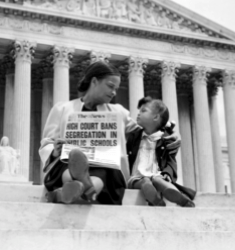
Educational Equity in the Face of Brown vs Board, 60 Years Later
“We have to keep in mind at all times that we are not fighting for integration, nor are we fighting for separation. We are fighting for recognition…for the right to live as free humans in this society.” –Malcolm X
This year we commemorate the 60th anniversary of Brown vs. Board of Education, a landmark advance in the struggle for racial justice and equality. In 1954, the Supreme Court made the decision that “separate and unequal” education was unconstitutional and denied Black children the right to equal protection under the law. A combination of five separate legal cases, the Brown vs. Board of Education decision was seen, in many ways, as a legendary step toward racial equality and a progressive change in education-policy that would set the precedent for eliminating Jim Crow segregation laws.
If Black students could attend the same schools as white students, this meant they could receive the same level of investment… right? Wrong. 60 years later, we have to ask ourselves, what has changed since the Brown vs. Board of Education decision? What kind of progress has been made? And how are students of color fairing as compared to their white counterparts?
While the notion of equity, particularly as it pertains to education, is one that most Americans say they stand for and are even willing to invest in, Black and Latino schools and communities face high rates of disinvestment and over-criminalization, a combination that proves to significantly reduce our student’s chances for success.
But there is an opportunity in front of us. Because of Proposition 30 and the resulting Local Control Funding Formula (LCFF), local communities now have the opportunity to reimagine how our schools can better address the barriers that too many students of color face in obtaining a high-quality education. By addressing the impact of over-policing and shifting investment away from policies that disproportionately impact students of color, we can find ourselves on a path toward the kind of education equity that our communities fought for in the 1950’s.
Using LCFF to shift investment away from policing and harsh discipline practices has the potential for major impact. All across the state, school districts have dramatically expanded their police forces in recent years. For example, Los Angeles Unified School District’s police department has over 510 officers and staff, while Oakland Unified School District has more than 115 law enforcement and security personnel. But rather than focusing on protecting students from safety threats that come from outside the school environment, the result in many communities has been the mass criminalization of students of color within the school environment.
While there is no evidence that reliance on police in California schools is keeping schools safer, there is plenty evidence that highlights the negative impact police interactions are having on our students. In fact, according to the most recently available data, well over 30,000 California students were referred to law enforcement in just one school year. At least 20,000 students were arrested or given a police ticket, and over 90% of them were youth of color. In addition, our precious school resources have increasingly been devoted to school police and security at the expense of the support and educational services our students need.
We can keep schools safe while also protecting students’ civil, human, and educational rights. In fact, across the country, school districts, state policymakers, and even the federal government are recognizing the urgent need to end the over-policing of schools and implement the many proven alternatives that promote healthy school climates, improved academic achievement, and greater school safety. Indeed, there is now widespread agreement that the best school safety strategies have little to nothing to do with police; instead, they involve taking a 360 degree approach to building the strong, supportive, high-functioning environments in which the full array of students’ developmental needs are met.
Now is the time, because we know that our schools will never be equitable so long as schools are being resourced inequitably. If some students attend caring, nurturing schools with regular access to guidance counselors, school psychologists, social workers, school nurses, and other support services, while other students attend heavily-policed schools in which they are always just one minor misstep away from being handcuffed, put in the back of a police cruiser, and winding up in juvenile court, what can we look back and say has changed since Brown vs. Board?
This year, will you allow Black and Brown students to continue being policed instead of supported, ending up another casualty of the “school-to-prison pipeline”? Or will you stand up against these policies and fight for our right to break the chains of the new separate and unequal?
